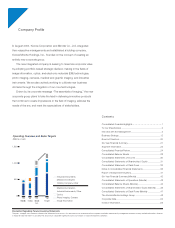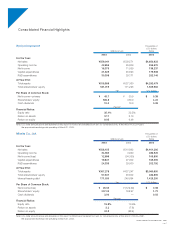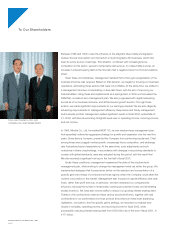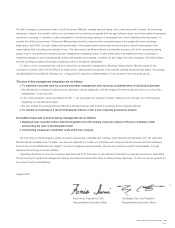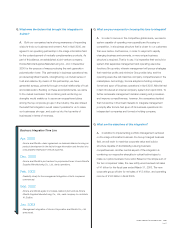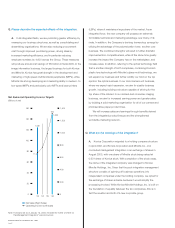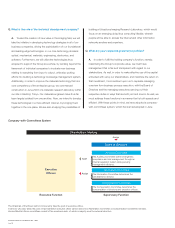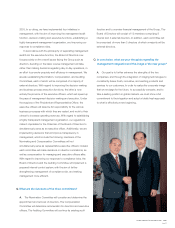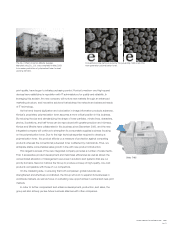Konica Minolta 2003 Annual Report Download - page 10
Download and view the complete annual report
Please find page 10 of the 2003 Konica Minolta annual report below. You can navigate through the pages in the report by either clicking on the pages listed below, or by using the keyword search tool below to find specific information within the annual report.
KONICA M INOLTA HOLDINGS, INC. 2 0 0 3
Pag e 8
Q. What are the functions of the holding company and
business companies after management integration?
A. The function of the holding company is to manage the
Group’s affairs in a fair and transparent fashion, allocate
management resources in an optimal manner through optimum
business portfolio management, and increase the corporate value
of the Group as a whole. The function of the business companies,
on the other hand, is to provide the maximum return on the
investments they receive from the holding company. They do
everything directly related to their respective business field,
functioning as independent companies, with maximum authority
delegated to them, while also being held strictly accountable.
Q. What is the resulting company’s post-integration business
structure?
A. To maximize the effects of the integration, and to generate
the greatest synergy, we will reorganize our business in October
2003, creating six business companies and two common function
companies under the umbrella of Konica Minolta Holdings, Inc.
The six business companies are as follows: Konica Minolta
Business Technologies, Inc., whose business field is MFPs, LBPs,
and related supplies; Konica Minolta Opto, Inc., whose business
field is optical elements such as optical pickup lenses,
microcamera units, and triacetyl cellulose (TAC) film for liquid
crystal display (LCD) polarizing plates; Konica Minolta Camera,
Inc., which consists primarily of digital cameras; Konica Minolta
Photo Imaging, Inc., which consists primarily of our photographic
film business; Konica Minolta Medical and Graphic, Inc., which
consists primarily of the medical and graphic imaging business;
and Konica Minolta Sensing, Inc., which consists of our color,
light, and shape measurement products. The common function
companies are Konica Minolta Technology Center, Inc., which is
responsible for the advancement of both leading-edge and basic
technologies in all fields, as well as incubation of R&D for new
business areas, and Konica Minolta Business Expert, Inc., which
undertakes information processing, distribution, and human
resources services on a companywide basis.
Q. What is your strategy for the image information business?
A. The primary business field is input and output products and
solutions in the networked office environment including MFPs and
LBPs. We intend to establish a solid place in the industry by
placing priority on allocating the management resources created
by the integration to color MFPs/LBPs and the medium- and high-
speed digital MFPs, which are growth sectors.
Our strategies include making inroads into the near-print
market, which includes devices that create completed business
documents, and vertical markets, by strengthening on-demand
printing and the polymerization toner business. We intend to build
a business structure that is highly creative and sensitive to the
market.
At the same time, we will improve customer satisfaction by
strengthening the ability to respond to the demand of key markets,
and establishing a product planning and development structure
capable of making us an industry leader in terms of solutions, as
well as reorganizing and improving our direct sales division.
Moreover, we will further improve on our strengths, and undertake
strategic alliances that will enable us to surpass the competition.
Q. What is your strategy for the optics business?
A. As the trend toward digital networking gains greater speed,
we are seeing tremendous growth in sales volumes of digital
products using optical components. Thus, this business is growing
in importance. Konica Minolta possesses unique optical
technologies such as flat plastic lens technology, where the
Company holds the top market share in this business field, and
advanced glass mold lens technology. Combining these superior


